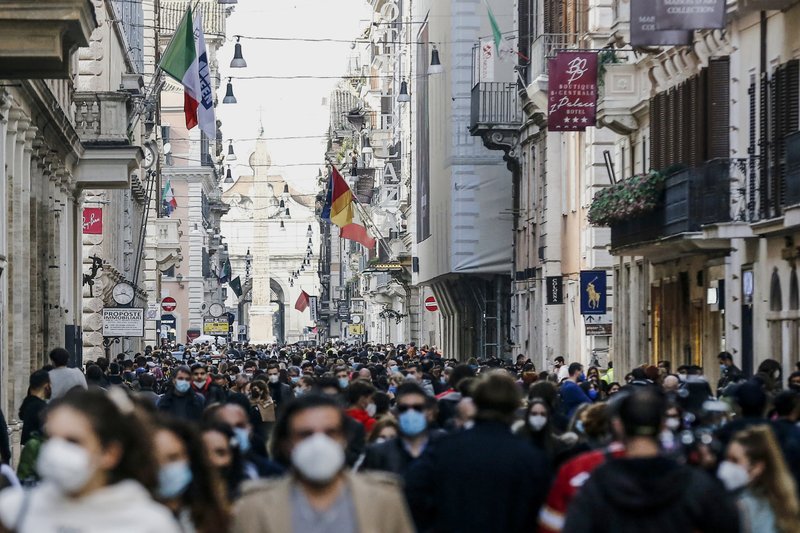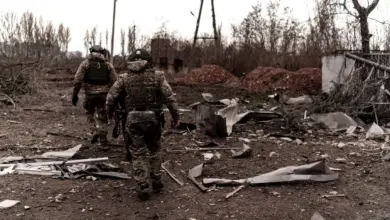
MILAN (AP) — The virus swept through a nursery school and an adjacent elementary school in the Milan suburb of Bollate with amazing speed. In a matter of just days, 45 children and 14 staff members had tested positive.
Genetic analysis confirmed what officials already suspected: The highly contagious coronavirus variant first identified in England was racing through the community, a densely packed city of nearly 40,000 with a chemical plant and Pirelli bicycle tire factory a 15-minute drive from the heart of Milan.
“This is the demonstration that the virus has a sort of intelligence, even if it is a single-cell organism. We can put up all the barriers in the world and imagine that they work, but in the end, it adapts and penetrates them,” lamented Bollate Mayor Francesco Vassallo.
Bollate was the first city in Lombardy, the northern region that has been the epicenter in each of Italy’s three surges, to be sealed off from neighbors because of mutant versions that the World Health Organization says are now powering another uptick in infections across Europe. The variants also include versions first identified in South Africa and Brazil.
Europe recorded 1 million new COVID-19 cases last week, an increase of 9% from the previous week and a reversal that ended a six-week decline, WHO said Thursday.
“The spread of the variants is driving the increase, but not only,” said Dr. Hans Kluge, WHO regional director for Europe, citing “also the opening of society, when it is not done in a safe and a controlled manner.”
The so-called U.K. variant is spreading significantly in 27 European countries monitored by WHO and is dominant in at least 10 by the agency’s count: Britain, Denmark, Italy, Ireland, Germany, France, the Netherlands, Israel, Spain and Portugal.
It is up to 50% more transmissible than the virus that surged last spring and again in the fall, making it more adept at thwarting measures that were previously effective, WHO experts warned.
“That is why health systems are struggling more now,” Kluge said. “It really is at a tipping point. We have to hold the fort and be very vigilant.”
In Lombardy, which bore the brunt of Italy’s spring surge, intensive care wards are again filling up as more than two-thirds of new positive tests are of the UK variant, health officials said this week.
After putting two provinces and some 50 towns on a modified lockdown, Lombardy’s regional governor announced tightened restrictions on Friday and closed classrooms for all age groups. Cases in Milan schools alone surged 33% in a week, the head of the provincial health system said.
The situation is dire in the Czech Republic, which registered a record-breaking total of nearly 8,500 patients in the hospital with COVID-19 this week. Poland is opening temporary hospitals and imposing a partial lockdown as the variant has grown from 10% of all infections in February to 25% now.
Kluge cited Britain’s experience as cause for optimism, noting that well-considered restrictions and the introduction of the vaccine have helped tamp down the variants there and in Israel. The vaccine rollout in the European Union, by comparison, is lagging, mostly because of supply problems.
In Britain, the emergence of the more transmissible strain sent cases soaring in December and triggered a national lockdown in January. Cases have since plummeted, from about 60,000 a day at the peak in early January to about 7,000 a day.
Still, a study shows the rate of decline slowing, and the government says it will tread cautiously with plans to ease the lockdown. That process begins Monday with the reopening of schools. Infection rates are highest in people ages 13 to 17, and officials will watch closely to see whether the return to class brings a spike in infections.
While the U.K. variant is dominant in France, forcing lockdowns in the French Riviera city of Nice and the northern port of Dunkirk, the variant first detected in South Africa has emerged as the most prevalent in the Moselle region, which borders German and Luxembourg. It represents 55% of the virus circulating there.
The South Africa variant also is predominant in a district of Austria that extends from Italy to Germany, with Austrian officials announcing plans to vaccinate most of the 84,000 residents to curb its spread. Austria is also requiring motorists along the Brenner highway, a major north-south trucking route, to produce negative test results.
The South Africa variant, now present in 26 European countries, is a source of particular concern because of doubts over whether the current vaccines are fully effective against it. The Brazilian variant, which appears capable of reinfecting people, has been detected in 15 European countries.
WHO and its partners are working to strengthen the genetic surveillance needed to track variants across the continent.
The mayor of Bollate has appealed to the regional governor to vaccinate all 40,000 residents immediately, though he expects to be told the supply is too tight at the moment.
Bollate has recorded 3,000 positive cases and 134 deaths — mostly among the elderly — since Italy was stricken a year ago. It took the brunt in November and December, in the fall resurgence, and was caught completely off guard when the variant arrived, racing through school-age children before hitting families at home.
“People are starting to get tired that after a year there is no light at the end of the tunnel,” Vassallo said.
___
AP correspondents Jill Lawless in London, Karel Janicek in Prague, Vanessa Gera in Warsaw, Jamey Keaten in Geneva, Sylvie Corbet in Paris, Geir Moulson in Berlin and Jovana Gec in Belgrade contributed.
___
Image: FILE – In this Saturday, Feb. 7, 2021 file photo, people crowd Via del Corso shopping street in Rome, following the ease of restriction measures to curb the spread of COVID-19. Europe recorded 1 million new COVID-19 cases last week, an increase of 9% from the previous week and ending a six-week decline, WHO said Thursday, March 4, 2021. The so-called UK variant is of greatest concern in the 53 countries monitored by WHO in Europe. (Cecilia Fabiano/LaPresse via AP)




